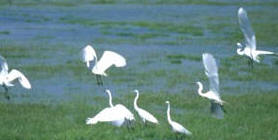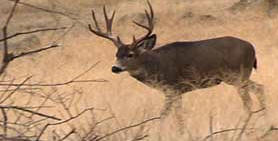|
|
Wetland Habitat and Sustainable Agriculture
 |
 |
| Leaseland farming and the Kuchel Act |
Walking Wetlands
Consistent with the Kuchel Act, 15,500 acres of the Refuge are leased for agricultural production. This lease-land acreage is important to local farmers and to the rural communities surrounding the Refuge. Agricultural production on the lease lands had a gross value of nearly $50 million in 1999 and generated $1.43 million in lease revenue for the Federal government.
In order to reduce pesticide use on the Refuge and reduce risks to Refuge fish and wildlife, the Service in cooperation with the Bureau of Reclamation and local farmers created an Integrated Pesticide Management (IPM) Plan in 1997. In developing the plan, it was felt that periodic flooding of agricultural lands would be a key IPM technique for suppressing plant parasitic nematodes as well as a host of other soils diseases and pests. This is a management plan that rotates blocks of farmland with flooded wetlands.
In participating in the Refuge's wetland/cropland program, growers have found that following wetland cycles, no soil fumigants are required at a savings of up to $200/acre. In addition, yields of some crops have increased up to 25%. The value of these benefits is apparent in recent lease rentals which are nearly twice those of adjacent conventionally farmed fields. In addition, several Refuge farmers have discovered that the soil pest and disease control function of wetlands is sufficient to allow for organic crop production. Based on increasing demand for organic acreage on the refuge, this program continues to expand.
One of the primary reasons for implementing an integrated program of wetlands and croplands was to enhance wildlife values with an emphasis on waterfowl and the diversity and abundance of other wetland wildlife species.
As a result of cooperative wetland restoration and enhancement programs, waterfowl use of Tule Lake NWR has increased to levels not seen in approximately 25 years.
The source of this information is Fish and Wildlife Service.
Partners:
U.S Fish and Wildlife, CalOreWetlands, California Waterfowl Association, University of California Davis, Tulelake Irrigation District, Ducks Unlimited, Klamath Water Users Association, USDA Natural Resource Conservation Service, California Department of Fish and Game, University of Washington, Seattle, Leaseland Advisory Council, Tulelake Growers Association, U.S. Geological Survey, Bureau of ReclamationHERE for articles, editorials, letters and facts